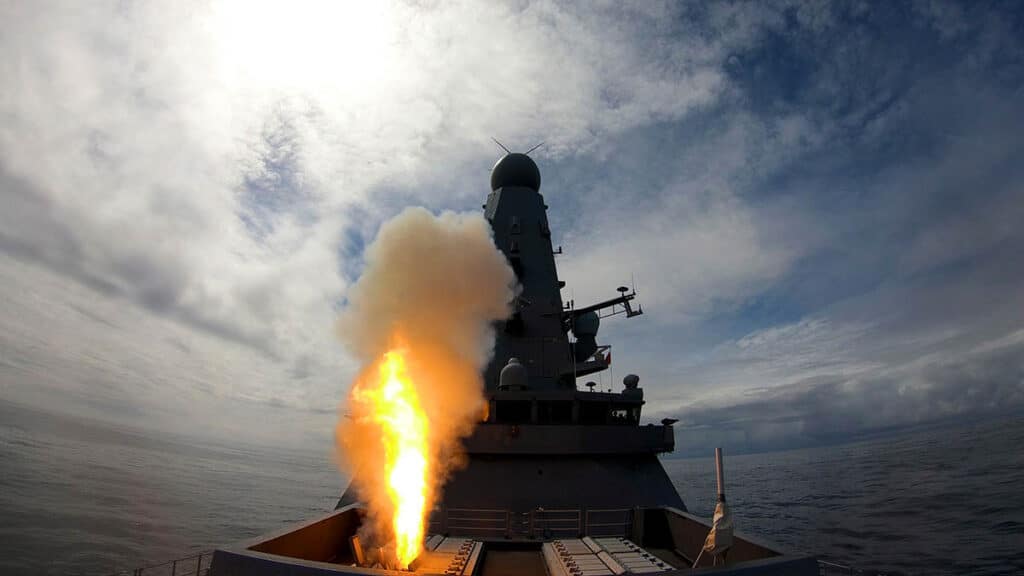What is being hailed as the “world’s largest test of naval and missile defenses,” a Royal Navy warship HMS Defender has effectively employed its Sea Viper missile system to destroy a jet drone.
Shangri La Dialogue: US ‘Heaps Praises’ On China’s Type-55 Super Destroyers While USS Zumwalt Lags Behind
Royal Navy’s £1 billion HMS Defender was deployed to Scotland’s Outer Hebrides to participate in Formidable Shield 2023, an extensive testing exercise involving 13 NATO and partner nations.
The exercise aimed to evaluate the performance of missiles, systems, sensors, and software against various targets, including ballistic, subsonic, and supersonic threats.
The Royal Navy’s Type 45 warship took the lead in the participation of the fleet, serving as a dedicated air defense destroyer with the mission to safeguard a task group.
Highlighting its capabilities, the warship’s primary weapon, the Sea Viper missile system, was deployed during a critical operation to locate and eliminate a drone designed to be “difficult to track and intercept.”
HMS Defender deployed to the Outer Hebrides for 'Exercise Formidable Shield 2023' to test weapons against ballistic, subsonic and supersonic targets. Here she is shooting down a drone. pic.twitter.com/50SGuDg1FD
— George Allison (@geoallison) June 2, 2023
The UK Navy said in an official statement that Petty Officer Cameron McDonnell operated the Sea Viper missile system from HMS Defender, targeting and engaging the highly maneuverable drone known as Bruiser 9384.
This particular drone is capable of reaching speeds of several hundred miles per hour. The NATO codeword “Bruiser” is assigned to signify an anti-ship missile.
Describing his role in the operation, Petty Officer Cameron McDonnell stated that his responsibility is to ensure missile and air defense capabilities.
He elaborated on the rigorous testing conducted during the exercise, utilizing experimental hardware and software to maximize the performance of sensors in preparation for future conflicts.

Throughout the testing, various targets, including ballistic, subsonic, and supersonic threats, were successfully tracked in collaboration with allied nations and partners.
The final stage of the exercise involved HMS Defender actively engaging and neutralizing an unmanned aerial vehicle through a live missile engagement, further showcasing the warship’s operational effectiveness.
Equipped with formidable firepower, every Type 45 destroyer can accommodate up to 48 missiles stored in vertical-launch silos on the ship’s forecastle.
These missiles have a range of up to 75 miles, enabling them to neutralize aerial threats effectively. Furthermore, they can maneuver with intense G forces to ensure precise target engagement.
Sea Viper Missile System
Developed jointly by France, Italy, and the UK, the Principal Anti-Air Missile System (PAAMS) represents an integrated anti-air warfare solution utilized by the Royal Navy, French Navy, and Italian Navy.
Within the Royal Navy, this system is referred to as Sea Viper or PAAMS(S), distinguishing it from the PAAMS system found on the Franco-Italian Horizon Class due to the incorporation of the SAMPSON radar.
Following the United Kingdom’s departure from the ‘Common New Generation Frigate’ project in October 1999, the decision was made to pursue a dedicated national warship design, leading to the development of the Type 45 destroyer.
Consequently, in January 2009, the PAAMS system was officially named Sea Viper by the Royal Navy.
The Sea Viper system is an advanced and complex defense system comprising various components, such as long-range and missile-directing radars, a combat control center, and vertical launcher missile silos.

Its main goal is to safeguard both land and sea forces from aerial threats and shield naval fleets from supersonic anti-ship missiles. With an impressive tracking capability, Sea Viper can monitor over 1,000 targets within a range of up to 400 kilometers.
Its purpose is to effectively track, engage, and neutralize a wide range of high-performance airborne threats, including low-altitude saturation attacks, supersonic cruise missiles, fighter aircraft, and unmanned aerial vehicles (UAVs).
Leveraging the Sylver Vertical Launching System, Sea Viper can launch up to eight missiles in under ten seconds while guiding up to 16 to their intended targets.
Meanwhile, the missile system is now undergoing a £300 million upgrade, known as Sea Viper Evolution, to enhance the Royal Navy’s defense against modern threats, including anti-ship ballistic missiles.
Under this program, all six Type 45 destroyers, namely HM Ships Daring, Dauntless, Diamond, Dragon, Defender, and Duncan, will also be equipped with the Sea Ceptor missile system in addition to vital enhancements made to their primary weapon, the Sea Viper.
The UK Navy said that this upgrade would strengthen the radar and missile capabilities and support 54 job positions across various locations in the UK, from the Isle of Wight to Hertfordshire, Bristol, and Bolton.
- Contact the author at ashishmichel(at)gmail.com
- Follow EurAsian Times on Google News




